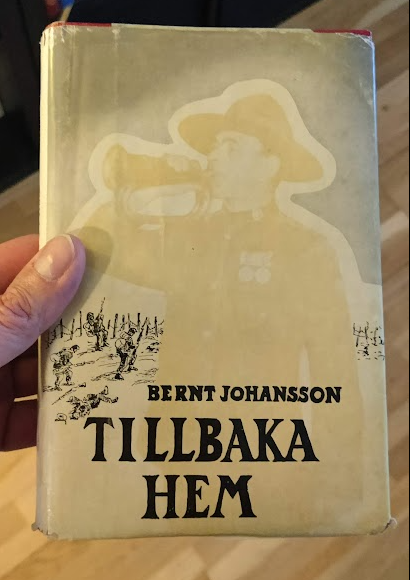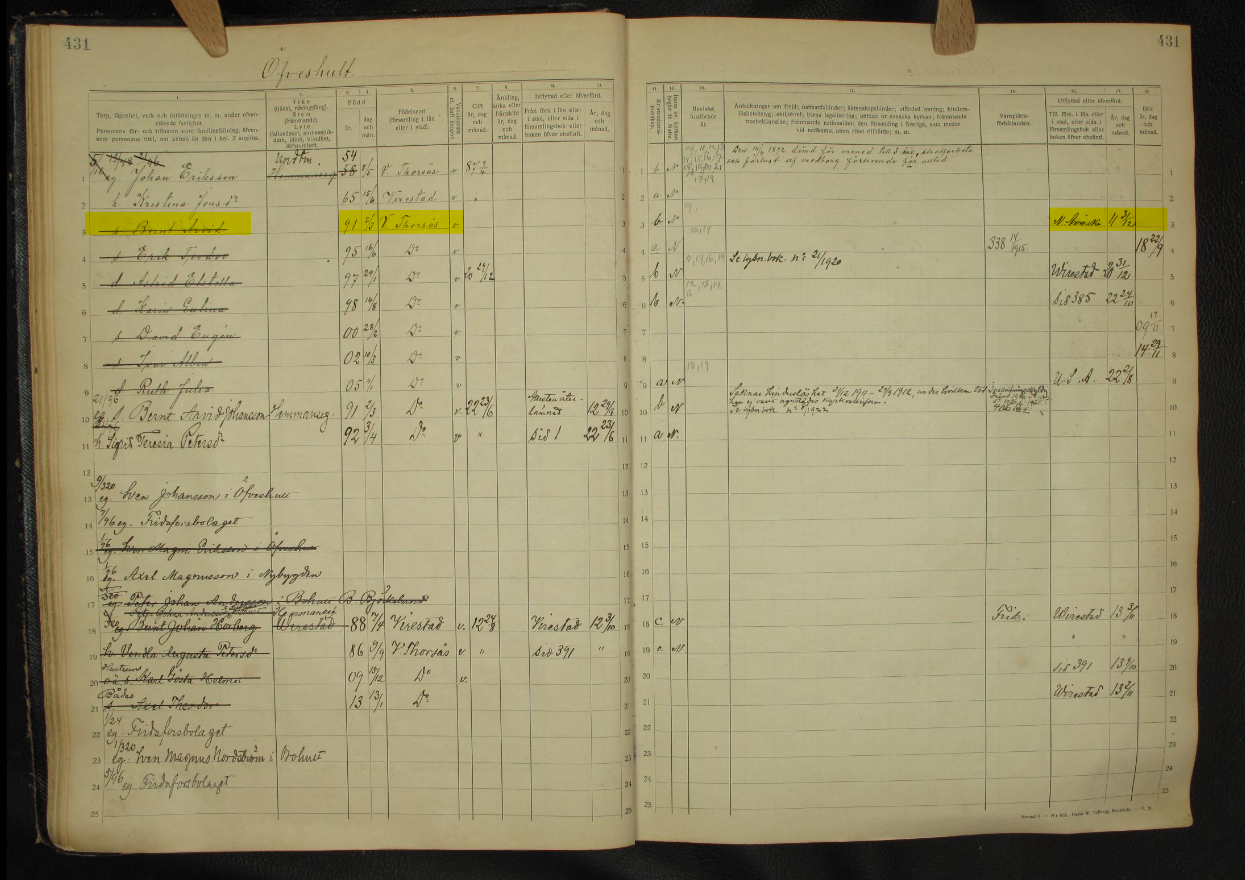One of the main reasons for working with my research is the connection to the individuals I discover through my intense work trying to find as much facts as possible to be able to tell their amazing stories, as soldiers on the Western Front in the Great War.
When having my talks I try to transfer the feelings I feel, to the audience, and most of the time the audience feels and understand what I am trying to tell, both the stories about the individuals and also the connection between the soldiers locations back in Sweden, to their final resting place in Belgium and France.
For about a week ago one of the guests to my guided tour in 2023, who also had heard me talking about my research a couple of times, contacted me about a book find. He wanted me to have it and asked me if he could send it to me as a gift.
That made me very happy of course. It turned out to be a story written by a Swedish born soldier, who fought in the great war, and kept the stories from his experiences in a diary, which the book is based on. An amazing piece of information, printed in 1959.
The book “Tillbaka hem”, “Back home”, written by the soldier in the 130th Infantry regiment USNG, 33rd Division, American Expeditionary Forces, who fought on the Western Front from August to November 1918.
But there is a mystery inside, that I haven’t been able to sort out yet. The story about his best friend, Dan, who fought and fell in a very tragic way, November 10th, 1918.
Please follow me in the story of Private 1/cl Bernt A Johnson (Bernt Arvid Johansson) and the great loss of his friend Dan.


Bernt Arvid was born in Västra Torsås parish, Kronoberg county, Sweden, March 2nd 1891. He was raised by his parents Kristina Jonsdotter and Johan Eriksson in Öveshult, Lönashult, Småland. Bernt had 6 siblings.
In the book he writes that he was 18 years old when he left Sweden and emigrated to North America in 1913, but as I will experience later on when I read the book, I think he struggled a bit with remembering his stories a bit differently to what they actually were.
Bernt Arvid was born in 1891 and left Sweden already in 1911, according to Swedish church books, which means he was around 20 year old when he arrived Ellis Island in New York together with his four friends. They split up and he is left all alone in New York, no money or nowhere to live.


In this situation he randomly passes one special place for the Swedish Immigrants, The Svea Hotel, and it was in this situation he met his friend and later on soldier in the same unit, Dan. Dan invited him for free, and from there Bernt found a way how to continue his life in the great country in the West. I haven’t yet found any information about this Swedish Immigrant safe haven.
Bernt later on moved to St. Paul in Minnesota, and in the registration cards he mention a friend, Nordgren, who lived nearby Bernt. Bernt lived at 660 Jessamine Ave, St Paul.
Bernt worked at Casino Palace, St. Paul before he was drafted and started his service at Camp Logan, Texas.

Bernt did his training at Camp Logan, Texas, before he one day sailed for France with his unit, Co “G”, 130th Infantry Regiment, 33rd Division. They arrived France in May, 1918. In his book he mentioned that they stepped on the ship “Agamemnon” May 7th, and the card says they sailed May 16th.

They spent their time in different parts of western France and in Paris, were educated and trained by british units before they went to the area west of Toul, near Tronville-En-Barrois, France.
Bernt spent a lot of time in the area, but all of his adventurous time was spent only in the two last days of the war, from the 9th to the 11th of November 1918. He mention in his book that they are supported by British tanks during their advancements, and there is only one place mentioned in this chapter, the village of Mézierés, but I am not sure in which geographical area that is. Please enlighten me if you as a reader have more information than me, I would really appreciate that.
On sunday November 10th he mention that he was involved in real action, and here he mention the village Villers-su Ally, which I haven’t been able to locate.
It is also hard to know if he is telling stories about things he had heard about or if he were involved in them, but he also mention the hard situations for those American engineer units who tried to build bridges over the river Meuse.
Bernt participated in fierce fightings against the Germans during this day, and he also managed to act bravely, for which he was awarded the French Croix De Guerre. Bernt and his fellow soldiers tried to find more wounded during their withdrawal and for a moment they were so far away from the frontline they thought it was OK to relax a bit, but then the horrible happened.

His best friend Dan, with, according to Bernt, had the surname of Charlstrom, was hit by a huge piece of shrapnel from a grenade, which separated Dan’s head from his body. Bernt and the other soldiers were totally shocked.
They managed to get permission to bury Dan the same day, November 10th, 1918, and in the book he mention that they bury Dan at the cemetery near Chateau-Thierry, in my opinion far east of the are which he mention to have been fighting in, but I can be wrong. I believe according to the photos in the book that it was near the place where the Aisne-Marne American Cemetery is today.

After 16 months in military service, Bernt left North America and went back to Sweden in June 1919. He felt that he had done his part of this War.
In 1958 Bernt and his wife decided to travel to France and to the Battlefields, where Bernt wanted to visit the grave of his best friend Dan Charlstrom. He describes that he is by his headstone in white marble, with the letters in Gold, and talking to Dan.
This part of the book gripped me a lot emotionally , as he did the same thing I am doing today, when I am visiting the soldiers I have in my research. He describes a lovely text in Swedish, “talking” to Dan. Dan was very important to Bernt, who was the first person he met when he had emigrated and who helped him during his time in North America.
But who was Dan Charlstrom? I have tried to find him in different archives, spelling his name in all ways, but I still can’t find him. Dan was, according to Bernt, born in New York by Swedish parents.
I really hope I can sort it out. According to the text in the book he must have died November 10th 1918, just one day before the armistice.
If anyone out there know more ways how to proceed, or maybe find him in any archive, feel free to contact me. May Dan rest in peace.

Thank you very much Bernt for your amazing story. I am very grateful having received this book from my friend Alf Görsjö. Thank you very much.
